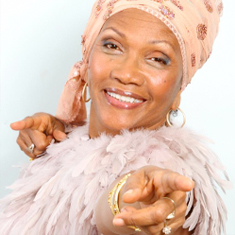In a genre traditionally dominated by male artists, Marcia Griffiths is arguably the best-known and most influential woman in the history of reggae. Griffiths first made a name for herself when the music was still evolving from its roots in ska and rocksteady, and she later became an ally of reggae’s signature artist, Bob Marley, before embracing the electronic-based sounds of dancehall and funk in the 1980s. Marcia Llyneth Griffiths was born in Kingston, Jamaica on November 23, 1949 (though Griffiths has sometimes told journalists she was born in 1953). She displayed an interest in music early on, singing in the church choir and regularly taking part in musical presentations at school, and she made her first steps toward a professional career when she was 15. Griffiths was singing at a friend’s party when she was overheard by Phillip “Boasie” James, a member of the vocal group the Blues Busters, who was visiting his girlfriend next door. James was impressed with Griffiths’ talent, and arranged for her to take part in an upcoming talent competition. Griffiths wowed the audience and was immediately invited to perform on a television variety show the same evening.
After this successful debut, she became a singer with Byron Lee & the Dragonaires, one of Jamaica’s most popular ska outfits, and was signed to a record deal with Studio One, the pioneering label founded by producer Clement “Coxsone” Dodd. At Studio OneGriffiths scored her first major hit with the 1967 single “Feel Like Jumping,” a rocksteady number that charted in Jamaica and Great Britain, and she would also enjoy chart success with the tunes “Melody Life” and “Truly” before cutting her first album, Marcia Griffiths at Studio One. In 1969, she first teamed up with Bob Andy of the Paragons as a duet partner, and when she moved from Studio One to the Trojan-affiliated Harry J label (run by musician and producer Harry Johnson), Andy followed suit, and their interpretation of Nina Simone’s “Young, Gifted and Black” became a major international hit in 1970. Bob and Marcia hit the charts again in 1971 with “The Pied Piper,” but in 1974 the duo parted ways and Griffiths released her second solo album, Sweet Bitter Love. In 1974, after Peter Tosh and Bunny Livingston left the Wailers, Bob Marley wanted to fill out the vocal sound of the group, and added a trio of female singers to the Wailers’ lineup. Griffiths became a member of the I-Threes alongside Rita Marley and Judy Mowatt, and after making their debut with Marley on the groundbreaking album Natty Dread, they were an integral part of the Wailers on-stage and in the studio until Marley’s death in 1981. The I-Threes also cut a pair of albums on their own after Marley’s passing, 1983’s Beginning and 1995’s Songs of Bob Marley.
Griffiths continued to record as a solo artist during her down time from the Wailers, cutting a pair of albums with producer Sonia Pottinger, 1978’s Naturally and 1979’s Steppin.’ Carousel In 1982, Griffiths cut an uptempo dance tune, “Electric Boogie,” which quickly became a major hit in Jamaica. The song gained an unexpected second life in 1989, when a disc jockey in Washington D.C. began spinning the record on a regular basis; the seven-year-old track jumped into the American charts, boosted by radio airplay as well as the growing popularity of a dance inspired by the song, the Electric Slide. (“Electric Boogie” also popped up on an album released by Island in America in 1990, Carousel.) As the Electric Slide became a regular feature at weddings and family get-togethers, “Electric Boogie” became a perennial favorite and established Griffiths in the United States. Through the ’90s and into the 21st century, Griffiths has continued to record and tour internationally on a regular basis, releasing albums that run the gamut from polished love songs to roots reggae to fiery dancehall sides (dueting with the likes of Shaggy, Buju Banton, and Cutty Ranks); she also reunited with Bob Andy for a pair of duet albums, Really Together in 1990 and Sweet Memories in 1997.
Source: All Music Guide

